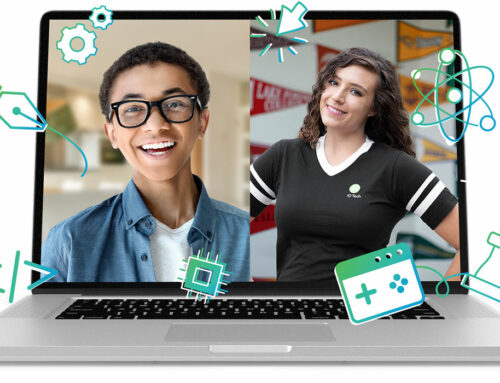Ubiquitous digital screens are a defining feature of our era. Movies, television, desktops, laptops, pads and tablets, cell phones, readers and gaming devices … many of us spend hours a day in front of a glowing blue screen. We work, play and depend on them for socialization and relaxation. The total amount of screen time for kids each day—an average of 6.5 hours—has more than doubled in the last 20 years.
The American Academy of Pediatrics recommends no more than one to two hours total screen time daily, but psychiatrist Victoria L. Dunckley, M.D., cautions that even that small amount can create problems for some children who exhibit adverse effects after that degree of exposure. Dunckley calls the adverse effects Electronic Screen Syndrome (ESS), symptoms of which include hyper-stimulation, hyper-focus, sleeplessness, nervous tics, irritability or rapidly changing moods, low tolerance for frustration, tantrums, depression, poor self-discipline, disorganized behavior, defiance, rage, meltdowns and antisocial behavior, poor sportsmanship, social immaturity, poor eye contact, stymied creativity, learning difficulties or a drop in school performance, poor short-term memory, and poor executive functioning (reasoning, judgment, task completion, planning, problem solving and critical thinking).
Over the past 10 years, the incidence of childhood ADHD has increased 50 percent. In Dunckley’s opinion, ESS may account, in part, for the exacerbation and misdiagnosis, or both, of childhood cases of ADD, ADHD and even bipolar disorder. Dunckley likens the effects of overuse of electronics on some children to stimulants such as caffeine, amphetamines or cocaine.
Screens Zap Our Brain Power
In “It’s Digital Heroine: How Screens Turn Kids into Psychotic Junkies,” Dr. Nicholas Kadaras asserts that children who feel lonely, alienated, bored, or who lack purpose are far more prone to become addicted to digital escapism. “We now know that those iPads, smartphones, and Xboxes are a form of digital drug. Recent brain imaging research is showing that they affect the brain’s frontal cortex—which controls executive functioning, including impulse control—in exactly the same way that cocaine does,” says Kadaras.
More frightening than addiction is how interactive screen time actually reshapes our brain. In “Gray Matters: Too Much Screen Time Damages the Brain” at PsychologyToday.com, Dunkley reports on multiple studies that conclude that interactive screen time atrophies our gray matter. Among the parts of the brain affected are the frontal lobe, which controls functions such as planning and impulse control; the striatum, which is involved in the suppression of socially unacceptable impulses; and the insula, which affects our capacity to develop empathy and compassion.
These can be frightening words for parents, but it’s important to remember that while it is good to be aware of ESS and watch for signs of imbalance, not every child responds in the same ways.
Not All Screen Time is the Same
So how is it that those of us who were raised in front of a television don’t exhibit ESS symptoms more? The answer seems to lie in the differences between two types of screen time:
- Passive screen time refers to activities in which the screen is across the room and the viewer has almost no interaction with it.
- Interactive screen time refers to activities in which the user interfaces with the device.
Both passive and interactive screen time can restructure expectations. Constant exposure to a panoply of fantasy graphics, sound effects and fast action can result in learners with short attention spans who crave entertainment and eschew essential learning skills such as memorization and working to solve difficult, multi-step problems.
Finding a Balance
Screen time can be used strategically to redirect back to reading. Consider using the impact-forming tendency of interactive screen time to enhance education. For example, the occasional use of a computer game can liven up math drills, and quality role playing simulations can help children understand historical events in context. Moreover, it could be beneficial after reading a literary classic to watch the movie adaptation then compare and contrast the two versions of the story.
We want to keep our children safe, but kids crave adventure and the excitement of a challenge. The digital environment offers children new frontiers to explore and the chance to play the hero in the relative safety of our homes. Unfortunately, the dangers inherent in digital adventure are real and hidden.
On the Other Hand, Video Gaming Comes with Some Benefits
Are Siri and Alexa Stunting Development of Kids’ Critical Thinking Skills? (5 Ways to Fight the Dumbing Effect of Technology)
By Sandi Schwartz
Are kids these day losing their minds—the ability to think critically and memorize facts? These two pillars of education may be in jeopardy in mainstream education, but homeschooling can build up what technology is causing to atrophy.
We’re sitting around the dinner table and a question comes up. Who won the World Series last year? What is the most populated state in America? Is a cucumber a fruit or vegetable? Instead of using our brains, we all whip out our handy devices and ask Siri, Alexa, or Google to find the answers for us. On one hand, it’s incredible that we can instantaneously find the answer to just about any question that pops in our head. On the other hand, I am concerned that our children’s brains are getting lazy. They no longer have to remember anything or spend time analyzing information because all the answers can be found with the click of a button or through voice recognition. How will kids ever learn to retain information and connect the dots if technology rapidly provides all the answers?
Technology has become a crutch that is diminishing our kids’ critical thinking skills. This is quite troublesome since critical thinking is the foundation of education and an essential life skill for survival and success. Psychology Today defines critical thinking as the “capacity to reflect, reason, and draw conclusions based on our experiences, knowledge, and insights.” Our children depend on this skill to communicate, create, build, and progress. Critical thinking is a complex process that combines a number of tactics including observing, learning, remembering, questioning, judging, evaluating, innovating, imagining, arguing, synthesizing, deciding, and acting. We use critical skills every single day to make good decisions, understand consequences of our actions, and solve problems.
Now that technology has infiltrated our children’s lives, critical thinking skills are harder to achieve. However, our children still need to be able to think critically even with all the gadgets that they can rely on. If our children can’t think for themselves, how will they function in this complex world? From solving puzzles to deciding when to cross the street to eventually competing in the job market for positions in science, engineering, health, social science, and other fields will require well-developed critical thinking skills.
For years, experts have been evaluating the impact of technology on critical thinking skills. According to Patricia Greenfield, UCLA professor of psychology and director of the Children’s Digital Media Center, children’s critical thinking skills are getting worse while their visual skills are improving. She analyzed more than 50 studies on learning and technology, including research on multitasking and the use of computers, the Internet, and video games. She found that real-time visual media do not allow for reflection, analysis, or imagination. In addition, reading for pleasure has declined among children and teens in recent decades, which is a concern because reading enhances imagination, reflection, and critical thinking in a way that visual media like video games and television do not.
Terry Heick, a former English teacher in Kentucky, explained to NPR that his eighth- and ninth-grade students immediately turn to Google for answers. They then report back what they find practically word for word, without thinking through the research. He wanted his students to take time to assess the information they needed, determine how to evaluate the data, and then address any conflicts they found. Instead, this new “search and find” process completely eliminated any need for critical thinking.
Next, in a 2008 article for The Atlantic titled “Is Google Making Us Stupid?” writer Nicholas Carr predicts how the Internet will take away our ability for contemplation due to the plasticity of our brains because we no longer have the need to concentrate or think through issues. Our kids may read more information overall, but since they really aren’t assessing it critically, they don’t actually process and recall much of it. Instead, they quickly move onto the next factoid that appears on the screen.
Finally, a 2011 study in the journal Science showed that when people know they have future access to information, they no longer need to recall or analyze it. Our children’s ability to grow their expand their memory is greatly impacted by all this technology, which affects their thinking skills. Knowing where to look for information has become more important for children than actually retaining that knowledge in their brains. The problem with this is that if our children don’t use their memory and analytical skills, they will lose it over time. Essentially, these devices are taking over basic functions of the brain like memory and critical thinking.
We are all in big trouble if our children lose the ability to think critically. It’s up to us to help them develop a critical mindset throughout their childhood. By instilling critical thinking skills from an early age, we will teach our kids how to effectively analyze the world around them. Here are some ways that you can enhance your children’s critical thinking skills at home.
5 Ways to Build Critical Thinking Abilities
Read Books for Fun and Family Bonding
As Patricia Greenfield discovered with her research, children are spending less time reading for fun because they are attached to their electronics. One downfall of this is that they are losing the opportunity to develop important comprehension and analytical skills from reading. Therefore, you can shift this pattern by reading with your children daily and discussing the material with them in ways that will challenge them to think critically. See if they can make connections between the story and their own life. Ask them to use what they have read so far to predict what will happen next. Have them summarize the key points of the story or chapter so they can determine what is most important. What roles did each character play and how do they relate to them? All of this practice with fun stories will help them analyze more challenging pieces of literature, both fiction and non-fiction, as they get older.
Explore Science
Science gives us a platform to raise educated children who have the ability to evaluate information presented to them to confront all types of critical issues that impact their lives. Science experiments and other related activities are fantastic ways to teach children how to think critically because they need to make predictions, evaluate data, and then interpret the scientific facts and findings to relate them to the world around them.
Use Old School Methods to Look for Answers and Evaluate Information
Young children have tons of questions. Take advantage of their curiosity to teach them how to look for answers to their questions in a critical way. If they ask how something works, take a trip to the library and find books, magazines, videos, and other resources on that topic. Provide opportunities for them to speak to people who can provide them direct answers. For example, if they want to know what a fireman does, schedule a trip to the local fire station so your child can learn firsthand how everything works. When your children are doing research online, sit with them and help them find reliable sources. Also show them the difference between evidence-based information and opinions. It’s probably a good idea to also explain fake news, as that has unfortunately become a recent trend. Our goal is to give our children the critical thinking skills so that they can spot unreliable sources on their own. It is so important that they know how to question what they read and to evaluate its validity.
Build Problem-Solving Skills
When dealing with conflicts, our children need to use critical thinking skills to understand the problem at hand and to come up with possible solutions. Use games, puzzles, riddles, mystery novels, physical challenges, and other activities to teach them problem solving skills.
Require Memorization of Basic Information and Wisdom Literature
Long gone are the days when we had all of our friends’ phone numbers stored in our heads. We have all become so lazy, relying on looking up every bit of information on our phones. In order to exercise your kid’s memory muscle, you can go a bit retro on them. Make sure they know some basic facts by heart like their address and important phone numbers. Also, see if they can give directions from home to school and other places you frequent. As they get older, continue to add more facts to this list like relatives’ birthdays, math equations, state capitals, and American Presidents—and of course, Scripture. The short and powerful proverbs will keep the memory sharp as iron sharpens iron with a repertoire of timeless wisdom.
***
Sandi Schwartz is a freelance writer/blogger and mother of two. She has written extensively about parenting, wellness and environmental issues. In addition to her blog Happy Science Mom, her work has appeared in many online and print publications including Chicken Soup for the Soul, Parent Co., Very Well, The Week and several regional parenting magazines.




Nowadays, kids really likes to be on screen most of the time and I really think that it’s bad because it can damaged their eyes and it can also kill their quality time with their family.